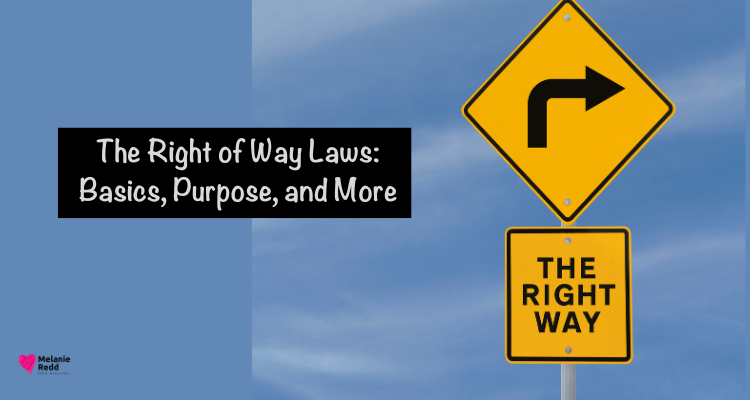The Right of Way Laws: Basics, Purpose, and More

The Right of Way Laws: Basics, Purpose, and More
Understanding right of way laws is crucial for ensuring road safety and minimizing accidents. These laws dictate which driver has the legal authority to proceed in various driving situations, such as intersections, pedestrian crossings, and merging lanes.
When these laws are violated, or, in other words, when vehicles fail to yield the right of way, the consequences can be severe. Truly, understanding when and how to yield the right of way can save lives, reduce injuries, and ensure that all road users—drivers, cyclists, and pedestrians—remain safe.
The Basics of Right of Way Laws
The right of way laws vary depending on the situation, but the fundamental principle is that certain road users have priority in specific scenarios. These laws create a structured traffic flow and lower road confusion. Some everyday situations where right of way laws apply include:
● Intersections: At a four-way stop, the first vehicle has the right of way. When two vehicles arrive simultaneously, the one on the right typically proceeds first. At a roundabout, drivers entering must yield to those already in the circle.
● Pedestrian Crossings: Drivers are required to give pedestrians the right of way at marked crosswalks and intersections. In many states, this rule also applies to unmarked crosswalks.
● Merging Lanes: When merging, the driver on the main road has the right of way. The merging vehicle must yield to avoid collisions.
● Emergency Vehicles: Fire trucks, ambulances, and police cars always have the right of way when their sirens and lights are activated. Drivers must pull over to the side of the road and allow these vehicles to pass.
The Purpose of Right of Way Laws
The primary purpose of right of way laws is to reduce the likelihood of accidents caused by uncertainty or misjudgment. These laws aim to,
● Prevent Collisions: Clear rules on who has the right of way reduces the risk of two vehicles or road users colliding, especially at intersections.
● Protect Vulnerable Road Users: Pedestrians, cyclists, and motorcyclists are more likely to be injured in an accident. Right of way laws help protect them by ensuring drivers know their responsibilities in shared spaces.
● Promote Efficient Traffic Flow: By establishing clear priorities, right of way laws help prevent bottlenecks and traffic jams, allowing vehicles to move smoothly and safely.
Common Violations and Their Consequences
Failing to yield the right of way is one of the most frequent traffic violations. This can happen for various reasons, such as distracted driving, aggressive driving, or simply not understanding the law. Common violations include:
● Not yielding to pedestrians at crosswalks: A severe infraction that can result in pedestrian injuries or fatalities. Sadly, there are many pedestrian fatalities and injuries. Over 67,000 pedestrians were injured nationwide in 2022, and 7,522 pedestrians lost their lives.
● Ignoring stop signs or traffic signals: Running a stop sign or red light violates right of way laws and increases the risk of high-speed collisions.
● Failure to yield when merging: This violation often leads to side-impact or rear-end collisions on highways and major roads.
Another Note
When someone doesn’t follow the right of way laws, they may face significant penalties, like license suspension or even criminal prosecution in case of major injury or death. Fines and points will affect your driving record, just to name a few.
In addition, after committing such infractions, insurance rates frequently rise, making the legal repercussions more expensive.
Final Thoughts on The Right of Way Laws: Basics, Purpose, and More
Right of way laws play a vital role in keeping our roads safe. Drivers who understand and follow these rules can significantly reduce the risk of accidents. Whether at an intersection, crosswalk, or merging lane, knowing when to yield and when to proceed is crucial for the safety of all road users.
For more information, explore resources like the National Safety Council or the IIHS to learn about the
complexities of right of way laws and their implications for traffic safety.
Were you encouraged by what you read?
Then, would you share this article with a friend, co-worker, or family member?
Or, maybe you can send it to a friend or family member?
This blog occasionally uses affiliate links and may contain affiliate links.
Additionally, Melanie Redd is a participant in the Amazon Services LLC Associates Program.
This is an affiliate advertising program designed to provide a means for sites to earn advertising fees. These are earned by advertising and linking to amazon.com.
Also, for more on my disclosure policy, click HERE.
© Melanie Redd and Hope Ministry, 2024. Unauthorized use and/or duplication of this material without express and written permission from this blog’s author and/or owner is strictly prohibited.
Further, excerpts and links may be used, provided that full and clear credit is given to Melanie Redd and Hope Ministry.
Please give appropriate and specific directions to the original content.



0 Comments